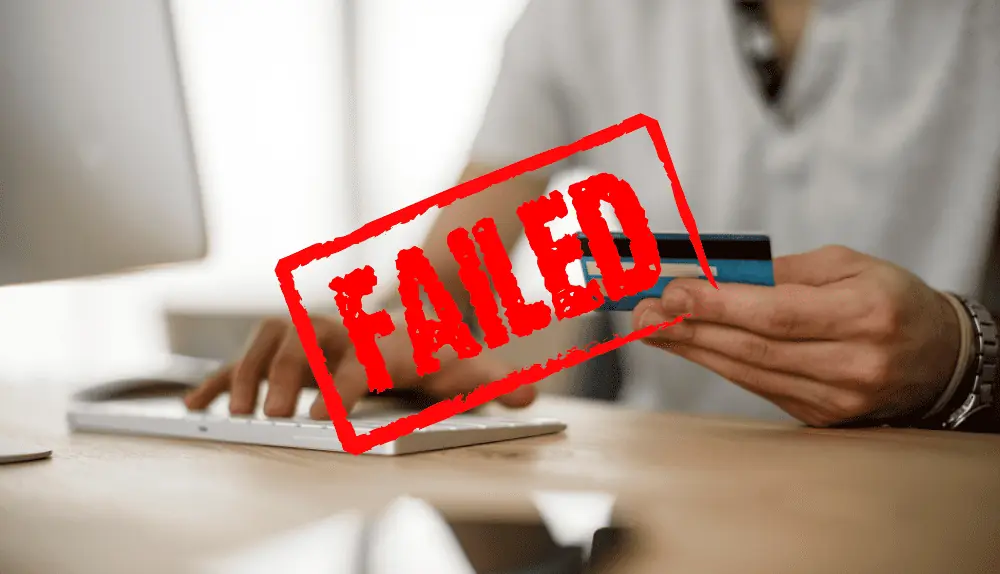In today’s fast-paced digital economy, businesses face the constant risk of failed transactions, leading to revenue loss, dissatisfied customers, and operational inefficiencies. This guide is designed to equip you with the knowledge and strategies necessary to prevent and recover failed payments proactively and recover from them swiftly when they do occur.
Whether you are a small business owner, a financial professional, or an entrepreneur, this comprehensive guide will empower you to optimize your payment processes, safeguard your revenue streams, and ensure a seamless customer experience. Get ready to unlock the secrets of successful payment management and take control of your financial operations.
What is Failed Payment?

A failed payment refers to a transaction that does not go through successfully due to various reasons. It occurs when a customer’s attempt to make a payment, typically through electronic means such as credit cards, debit cards, or online payment platforms, is unsuccessful. Failed payments can be caused by several factors, including insufficient funds in the customer’s account, expired or invalid payment details, technical issues during the transaction process, or even fraudulent activity.
These failures can have significant consequences for businesses, leading to lost revenue, disrupted cash flow, and potential damage to customer relationships. It is essential for businesses to have robust payment management systems in place to minimize the occurrence of failed payments. This involves implementing proactive measures to prevent payment failures, such as validating customer information, ensuring secure payment gateways, and regularly updating payment data.
Additionally, businesses should have effective procedures in place to promptly address and recover from failed payments, including customer notification systems, streamlined refund processes, and dedicated customer support to resolve any payment issues promptly. By understanding the causes and implications of failed payments and implementing appropriate strategies, businesses can mitigate the risks and ensure smooth financial operations.
Voluntary vs. Involuntary Churn
Voluntary churn and involuntary churn are two distinct types of customer attrition that businesses may experience. Understanding the differences between these churn types is essential for developing effective customer retention strategies.
Voluntary churn refers to customers who actively choose to discontinue their relationship with a business. This can occur due to various reasons, such as dissatisfaction with the product or service, finding a better alternative, or changes in personal circumstances. Voluntary churn is a result of customers making a conscious decision to cancel their subscription, terminate their contract, or stop using a product. Businesses can address voluntary churn by focusing on improving customer satisfaction, enhancing product offerings, providing exceptional customer service, and implementing loyalty programs to incentivize customer retention.
On the other hand, involuntary churn refers to customers who are lost due to factors outside of their control or without their intention to discontinue their relationship with the business. This can include situations such as expired credit cards, failed payment attempts, or involuntary cancellations due to technical issues. Involuntary churn is often a result of operational or administrative issues rather than customer dissatisfaction. To mitigate involuntary churn, businesses should optimize payment processes, implement effective communication channels to resolve billing issues, and provide easy ways for customers to update their payment information.
By understanding the distinctions between voluntary churn and involuntary churn, businesses can tailor their retention strategies accordingly. Proactive efforts to address customer concerns, improve satisfaction, and streamline payment processes can help minimize both types of churn, ultimately leading to increased customer loyalty and business success.
Why Does Payment Failure Occur?
Payment failures can disrupt the smooth flow of transactions and cause inconvenience to both businesses and customers. Understanding the reasons behind these failures is crucial for implementing effective prevention and recovery measures. Let’s explore some common factors that contribute to payment failures:
Insufficient Funds
One of the most prevalent causes of payment failure is insufficient funds in the customer’s account. When a transaction is initiated, the payment processor attempts to debit the required amount, but if there are insufficient funds, the transaction fails. This often occurs when customers forget to deposit enough money into their accounts or miscalculate their available balance.
Expired or Invalid Payment Details
Expired or invalid payment details, such as an expired credit card or incorrect billing address, can lead to payment failures. This can happen if customers do not update their payment information or mistakenly provide inaccurate details during the transaction process. In such cases, the payment processor is unable to authorize the payment, resulting in a failed transaction.
Technical Glitches
Technical issues can occur on either the customer’s or the merchant’s end, leading to payment failures. These glitches can include network connectivity problems, server errors, or software malfunctions. For example, if the payment gateway experiences a temporary outage, customers may encounter difficulties while making payments, resulting in failures.
Fraudulent Activity
Payment failures can also occur due to fraudulent activities, such as stolen credit card information or unauthorized transactions. In order to protect customers and businesses, payment processors employ various security measures to detect and prevent fraudulent transactions. If suspicious activity is detected during a payment attempt, it may be flagged as potentially fraudulent and subsequently rejected.
Payment Processor Issues
Sometimes, payment failures can be attributed to issues with the payment processor itself. This could include problems with their systems, internal errors, or maintenance downtime. While rare, these technical hiccups can disrupt the payment process and cause transactions to fail.
Overall, payment failures can occur due to various reasons, such as insufficient funds, expired or invalid payment details, technical glitches, fraudulent activity, or issues with the payment processor.
Preparing for Payment Failure
Payment failures can disrupt your business operations and impact your revenue stream. However, by taking proactive steps to prepare for potential payment failures, you can minimize their impact and ensure a smoother payment process. Here are some key strategies to consider when preparing for payment failure:
Diversify Payment Options
Offering multiple payment options can help reduce the risk of payment failure. Provide customers with various channels to make payments, such as credit cards, debit cards, online payment platforms, and alternative payment methods like digital wallets. By diversifying your payment options, you provide customers with alternatives if one method fails.
Implement Payment Validation and Verification
Utilize payment validation and verification mechanisms to minimize the occurrence of payment failures. Incorporate real-time address verification, card verification, and CVV verification to ensure the accuracy and validity of payment details. This helps reduce the chances of failed transactions due to incorrect or invalid information.
Regularly Update Payment Information
Encourage customers to update their payment information regularly, such as credit card expiry dates or billing addresses. Sending reminders or providing user-friendly interfaces to update payment details can help prevent payment failures caused by expired or inaccurate information.
Monitor Payment Processes
Keep a close eye on your payment processes to identify any potential issues or patterns of payment failure. Regularly review payment reports and analytics to gain insights into payment success rates, recurring payment issues, or any sudden changes in payment trends. This proactive monitoring allows you to identify and address payment failure risks promptly.
Maintain Strong Customer Communication
Establish clear and transparent communication channels with your customers regarding payment processes, potential issues, and how to resolve payment failures. Clearly communicate your refund and dispute resolution policies, and provide accessible customer support channels for assistance. Promptly notify customers of any failed transactions, providing instructions on how to rectify the issue.
Create Contingency Plans
Develop contingency plans to mitigate the impact of payment failures. This includes having backup payment processors or alternative payment methods in place to ensure business continuity. Consider establishing relationships with multiple payment service providers to have backup options readily available.
Educate and Train Staff
Ensure your staff is trained on payment processes, common issues related to payment failures, and steps to resolve them. Equipping your team with the necessary knowledge and skills will help them handle customer inquiries effectively and resolve payment failures efficiently.
By proactively preparing for payment failure, businesses can minimize disruption, maintain customer satisfaction, and ensure a smoother payment experience. Implementing diverse payment options, robust validation processes, regular updates of payment information, monitoring payment processes, maintaining strong customer communication, creating contingency plans, and educating staff will help you navigate payment failures effectively and protect your revenue stream.
How to Prevent and Recover Failed Payments Ahead of Time

Preventing failed payments is essential for maintaining a smooth payment process, maximizing revenue, and ensuring customer satisfaction. By implementing proactive measures and best practices, you can significantly reduce the occurrence of failed payments. Here are some key strategies to prevent failed payments ahead of time:
Ensure Clear Payment Terms and Policies
Clearly communicate your payment terms, including due dates, accepted payment methods, and any applicable fees or penalties. Provide this information upfront to set clear customer expectations and minimize payment failures resulting from misunderstandings or confusion.
Implement Robust Payment Validation
Utilize robust payment validation mechanisms to ensure accurate and valid payment information. Implement real-time address verification, card validation, and CVV checks to minimize errors and reduce the likelihood of failed transactions due to incorrect or invalid payment details.
Offer Diverse Payment Options
Provide customers with various payment options to increase the likelihood of successful transactions. Accept major credit cards, debit cards, online payment platforms, and alternative payment methods based on your target market’s preferences. Offering multiple options caters to customer preferences and reduces the risk of failed payments due to unavailable or unsupported payment methods.
Enable Auto-Pay and Scheduled Payments
Implement auto-pay and scheduled payment options to facilitate timely and automatic payments. This feature allows customers to set up recurring payments, ensuring on-time payments without the need for manual intervention. Encourage customers to enroll in these convenient payment options to minimize the risk of missed payments.
Send Payment Reminders
Send timely payment reminders to customers, especially for recurring payments or outstanding balances. Use email, SMS, or automated notifications to remind customers of upcoming payment due dates. This proactive approach helps customers stay on top of their payments and reduces the chances of missed or delayed payments.
Store and Secure Payment Information
Implement secure payment storage systems to store customer payment information securely. Ensure compliance with industry-standard security measures and regulations to protect sensitive customer data from unauthorized access or data breaches. Safely storing payment information allows for seamless future transactions without customers needing to re-enter their details, reducing the risk of errors or payment failures.
Monitor Payment Systems
Regularly monitor your payment systems and review payment reports and analytics to identify potential issues or trends. Keep an eye out for patterns of payment failures or declined transactions. Proactive monitoring allows you to quickly identify and address potential problems before they escalate into widespread payment failures.
Update Payment Processes
Regularly update and optimize your payment processes based on industry best practices and customer feedback. Stay informed about emerging payment technologies, security standards, and regulatory changes. Implement necessary updates and enhancements to maintain a reliable and efficient payment infrastructure.
By implementing these preventive strategies, you can significantly reduce the occurrence of failed payments and ensure a smooth payment experience for both your business and customers. Taking proactive measures, such as clear communication, robust validation, diverse payment options, payment reminders, secure payment storage, monitoring systems, updated processes, customer education, and exceptional support, will strengthen your payment infrastructure and minimize the risk of payment failures.
How to Recover Failed Payments

When a payment failure occurs, it is crucial to respond swiftly and effectively to recover the lost transaction and maintain customer satisfaction. Promptly addressing payment failures not only helps resolve the immediate issue but also demonstrates your commitment to customer service. Here are some key steps to take when recovering from failed payments:
Identify and Notify Customers
Monitor your payment systems to identify failed transactions as soon as possible. Once a payment failure is detected, notify the customer promptly through automated email notifications, SMS alerts, or other communication channels. Clearly communicate the reason for the failure and provide instructions on rectifying the issue.
Offer Self-Service Options
Enable customers to resolve payment failures on their own whenever possible. Provide a self-service portal or user-friendly interface where customers can update their payment information, correct errors, or retry the transaction. Offering self-service options empowers customers to take immediate action and increases the chances of successful payment recovery.
Provide Customer Support
In addition to self-service options, ensure that dedicated customer support channels are available to assist customers with payment recovery. Offer multiple support channels, such as phone, email, or live chat, and ensure your support team is well-trained and equipped to handle payment-related inquiries efficiently. Promptly respond to customer queries and provide personalized assistance to resolve payment failures.
Retry Failed Transactions
Implement automated retry mechanisms for failed transactions. Set up a system that automatically retries failed payments after a specific interval, giving customers an opportunity to address any temporary issues that may have caused the initial failure. Gradually increase the retry frequency based on your business requirements and payment provider’s guidelines.
Verify Payment Information
If a payment failure occurs due to incorrect or outdated payment information, work with the customer to verify and update the details. Provide clear instructions on how to update payment information securely, either through a self-service portal or by contacting customer support. Regularly validate payment information to prevent future failures.
Streamline Refund Processes
If a payment failure cannot be resolved or the customer requests a refund, ensure your refund process is streamlined and efficient. Clearly communicate your refund policies and timeframes to customers, and promptly process refunds once a payment failure is confirmed. Provide confirmation emails or receipts to customers to keep them informed about the refund status.
Analyze and Address Root Causes
Regularly analyze the root causes of payment failures to identify trends or recurring issues. This analysis will help you address underlying problems and implement preventive measures to reduce the occurrence of future failures. Identify patterns, such as specific payment methods or transaction types that frequently fail, and take corrective actions accordingly.
Enhance Payment Security
Implement robust security measures to protect against fraudulent transactions, which can lead to payment failures. Use advanced encryption techniques, implement fraud detection systems, and follow industry best practices for secure payment processing. Regularly update your security protocols to stay ahead of evolving threats.
Learn from Feedback
Encourage customers to provide feedback on their payment experience and specifically on any failed payment incidents. Analyze customer feedback to identify areas for improvement in your payment processes. By addressing customer concerns and making necessary adjustments, you can enhance your payment system’s reliability and reduce future payment failures.
Maintain Customer Relationships
Throughout the payment recovery process, prioritize maintaining positive customer relationships. Apologize for any inconvenience caused by the payment failure and demonstrate your commitment to resolving the issue promptly. Offer incentives or discounts for future transactions as a gesture of goodwill, reinforcing your dedication to customer satisfaction.
Recovering from failed payments requires a proactive and customer-centric approach. By promptly identifying and notifying customers, offering self-service options, providing customer support, retrying failed transactions, verifying payment information, streamlining refund processes, analyzing root causes, enhancing payment security, learning from feedback, and maintaining customer relationships, you can effectively recover from payment failures, minimize customer frustration, and uphold your reputation for reliable payment processing.
Final Words
In conclusion, preventing and recovering from failed payments is vital for businesses to maintain a seamless payment process, maximize revenue, and uphold customer satisfaction. By implementing proactive measures such as diverse payment options, robust validation mechanisms, clear communication, automated retry systems, and efficient customer support, businesses can significantly reduce the occurrence of payment failures.
Additionally, creating contingency plans, analyzing root causes, enhancing payment security, and continuously improving payment processes are crucial for preventing failed payments ahead of time. In the event of a payment failure, promptly identifying and notifying customers, offering self-service options, verifying payment information, streamlining refund processes, and maintaining positive customer relationships are key steps in recovering from such incidents. By adopting these strategies and taking a customer-centric approach, businesses can minimize the impact of failed payments, build customer trust, and ensure a smooth payment experience, ultimately contributing to long-term success and growth.
Frequently Asked Questions (FAQs)
Why do payment failures occur?
Payment failures can occur due to various factors, including insufficient funds, expired or invalid payment information, technical glitches, network connectivity issues, or security measures triggered by the payment processor.
What should I do if my payment fails?
If your payment fails, you can take several steps to resolve the issue. First, check your payment information for accuracy, including card details, billing address, and available funds. If everything is correct, contact your payment provider or the merchant’s customer support to investigate and resolve the issue.
Can failed payments be recovered?
In many cases, failed payments can be recovered. By promptly addressing the issue, verifying payment information, retrying the transaction, or updating payment details, you can often resolve the failed payment and complete the transaction successfully.
Will I be charged for a failed payment?
Typically, failed payments do not result in charges since the transaction was not completed. However, checking with your payment provider or the merchant to confirm their specific policies regarding failed payments is advisable.
How can businesses prevent failed payments?
Businesses can prevent failed payments by implementing measures such as robust payment validation, diverse payment options, clear communication of payment terms, offering self-service options, and regularly updating and optimizing payment processes.
What should businesses do if they experience a high rate of failed payments?
If a business experiences a high rate of failed payments, it is essential to investigate the root causes. Analyze payment reports, communicate with customers to understand their concerns, and make necessary adjustments to payment processes, systems, and customer support to mitigate the issue and prevent future payment failures.
Can I get a refund if my payment fails?
If your payment fails and you were charged for the transaction, you can typically request a refund. Contact the merchant or payment provider to inquire about their refund policy and initiate the refund process.
Remember that specific circumstances and policies may vary depending on the payment provider, merchant, or individual situation. It is always recommended to reach out to the relevant parties for accurate and up-to-date information regarding failed payments and recovery.

